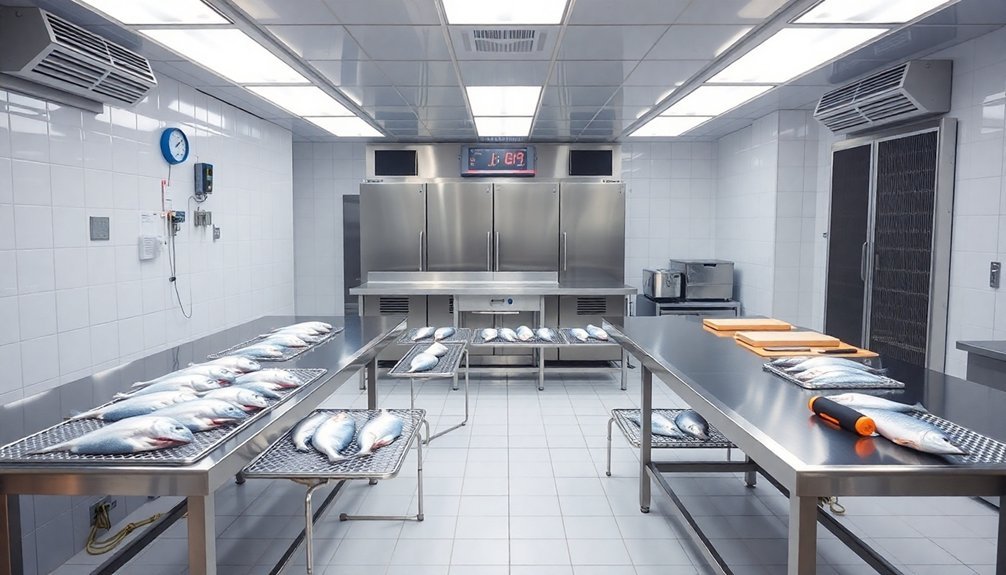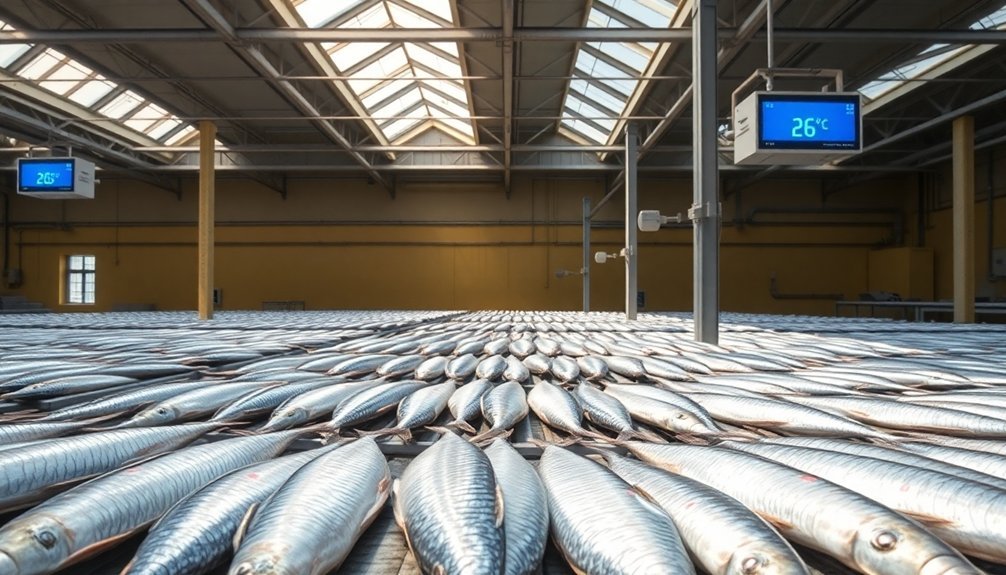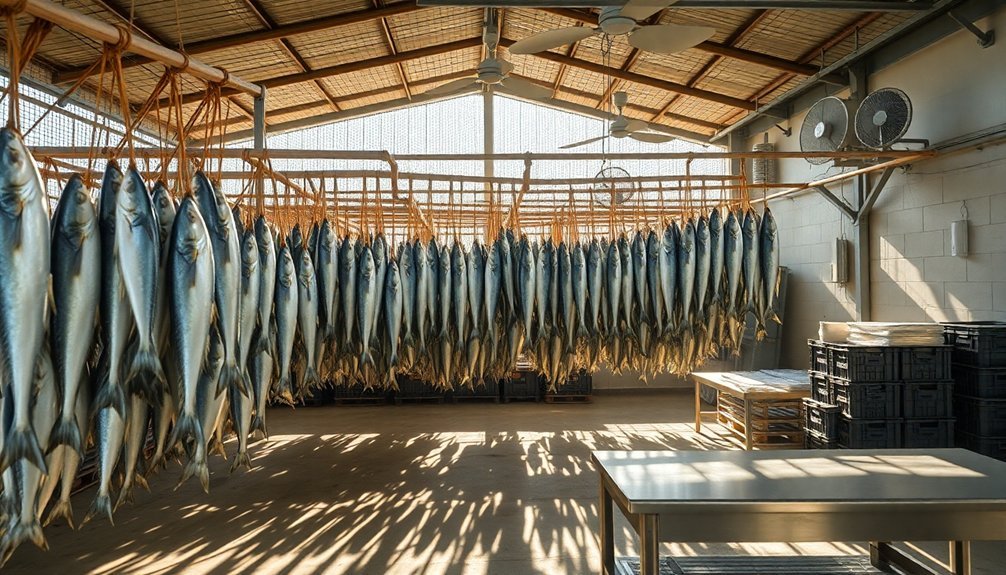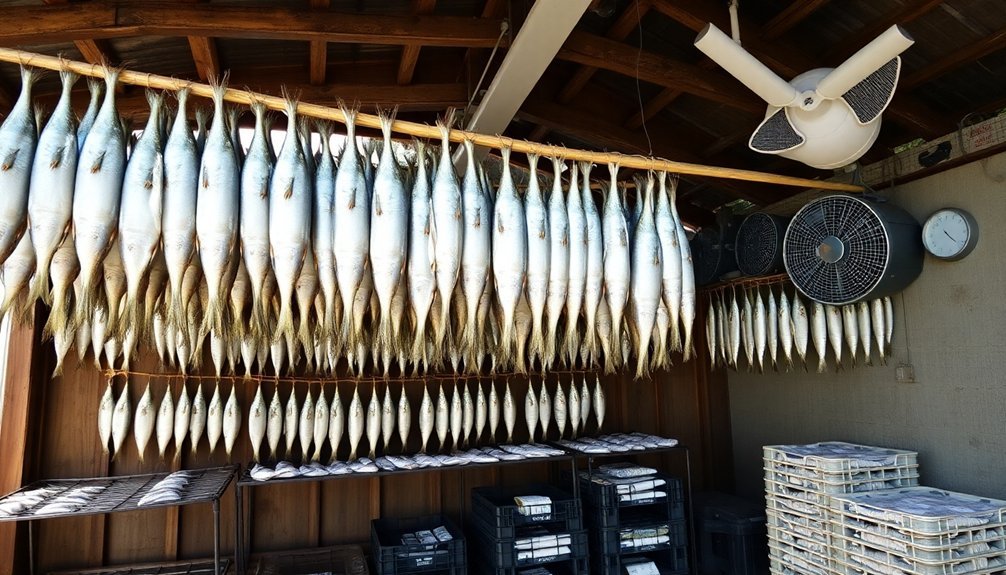To scale up your air-dried fish production effectively, you'll need to focus on five key areas. Start by optimizing your pre-processing with a 30% sodium chloride ratio and proper environmental controls. Next, invest in multi-chamber drying systems with digital monitoring capabilities and uniform air circulation. Master your temperature control by maintaining processing temps between 8-12°C and storage below 4°C. Implement thorough quality monitoring through sensory panels and regular testing. Finally, establish proper storage with vacuum-sealed packaging and well-ventilated facilities. These foundational steps will release your operation's full production potential.
Optimize Your Pre-Processing Setup

When establishing a scaled-up air-dried fish operation, optimizing your preprocessing setup serves as the foundation for consistent, high-quality products.
You'll need to implement both traditional and novel preprocessing techniques to maximize efficiency and preserve product quality. Consider utilizing analytical software tools to track and visualize your production data metrics. Start by selecting appropriate salting and brining methods, using a 30% sodium chloride ratio to raw material weight, and maintain precise control over treatment times.
Consider incorporating advanced preprocessing technologies like ultrasound or electric fields to modify tissue structure while preserving flavor and nutrients.
You'll want to guarantee your facility maintains proper environmental controls, keeping air velocity at least 3 m/s and temperatures below 40°C. Set up your preprocessing area with controlled environments like industrial ovens or drying tunnels for consistent treatment conditions.
Don't overlook the importance of handling procedures. Implement careful stacking and mixing protocols to prevent contamination, and establish precise measurement systems for monitoring sample weight, flow velocity, and humidity levels.
You'll also need to verify complete surface water removal before proceeding with drying. Remember that different aquatic products require specific preprocessing approaches, so adjust your setup accordingly based on the fish species you're processing.
Invest In Quality Drying Equipment
Due to the critical role of drying equipment in large-scale fish processing, you'll need to invest in high-quality machinery that secures consistent results.
Look for systems equipped with multiple drying chamber trays that provide adequate spacing for uniform air circulation around each fish piece.
When selecting your equipment, prioritize models with sophisticated temperature control systems and digital monitoring capabilities.
You'll want a machine that offers automatic temperature regulation, humidity sensors, and data logging features to maintain consistent drying conditions and track quality metrics.
Be certain the system includes high-temperature alarms to prevent product damage.
Choose equipment with efficient air circulation and moisture removal systems.
Your drying chamber should have powerful fans that distribute hot air evenly, coupled with an effective exhaust system that quickly removes moisture through dehumidifiers. This combination prevents mold growth and secures proper drying.
Consider your operation's scale when selecting equipment capacity. Energy-efficient operations can significantly reduce long-term costs while minimizing environmental impact.
Modern drying systems come in various sizes to accommodate different production volumes.
You'll also want adjustable parameters for temperature and drying time, allowing you to process different fish types and thicknesses effectively while maintaining product quality.
Master Temperature Control Systems

Mastering temperature control systems stands at the heart of successful air-dried fish production. You'll need to maintain temperatures between 8°C and 12°C during processing operations, while guaranteeing refrigerated storage stays below 4°C to prevent bacterial growth. Modern DanX air handling units can support optimal climate control across your facility.
Your facility must adapt to both internal and external conditions, with automated systems helping you adjust settings based on different processing stages and shift patterns.
To optimize your temperature control system, consider these critical factors:
- Monitor real-time humidity levels and keep them below 45% RH to prevent condensation and equipment corrosion
- Install post-cooling systems using ice water to maintain consistent cool temperatures
- Utilize heat pump systems during drying phases for energy-efficient operations
- Set up automated controls that adjust to external weather patterns and internal processing needs
You'll want to maximize ventilation and heating during washing and drying phases to guarantee quick moisture removal.
Don't forget to harness surplus heat energy from ice water processes to reduce operational costs. Your system should continuously monitor conditions to maintain compliance with food safety regulations while preventing freezer burn and maintaining product quality.
Streamline Quality Monitoring Processes
Streamlining your quality monitoring processes requires a multi-layered approach combining advanced sensory evaluation, spectral analysis, and precise microbiological testing.
Start by training your quality assessment panel to evaluate color, odor, texture, and insect infestation using standardized hedonic scales. Implement the Quality Index method to guarantee consistent grading across your production line.
You'll need to integrate Hyperspectral Imaging (HSI) in the 400-1000 nm range to monitor quality changes objectively. Use the CARS method to select suitable wavelengths, and combine this data with LSSVM for accurate predictions. This technology enables you to visualize quality changes pixel by pixel, reducing subjective assessments.
Don't overlook microbiological testing – conduct regular standard plate counts and aerobic plate counts on nutrient agar media. Monitor total bacterial colony counts and guarantee they meet international standards.
Check biochemical composition through protein, lipid, ash, and moisture content analysis. Maintain strict environmental controls by using elevated drying tables with polythene covers and monitoring temperature and humidity levels with digital tools.
These measures will help you maintain consistent quality throughout your scaled-up production process.
Scale Storage And Distribution

A robust storage and distribution system forms the backbone of successful air-dried fish production. You'll need to focus on proper storage conditions and efficient distribution methods to maintain product quality.
Start by setting up a dry, cold cellar with well-ventilated caches to prevent moisture buildup and mold formation. Keep your product elevated off the ground and protected under a solid roof.
For packaging, you've got several effective options to preserve quality and extend shelf life. Use vacuum-sealed bags or HDPE packaging for long-term storage, or opt for glass mason jars and plastic zipper bags for smaller quantities. Don't forget to apply a thin coat of vegetable oil before freezing to enhance preservation.
Here's what you'll need for an effective storage and distribution system:
- Well-ventilated transportation vehicles with stable temperature control
- Insulated containers for long-distance shipping
- Clear labeling and dating system for inventory tracking
- Regular sanitation schedule for all storage facilities
Remember to monitor your storage areas regularly for signs of moisture or contamination.
Keep your distribution routes planned to minimize exposure to humid environments, and always maintain proper ventilation throughout the entire process.
Frequently Asked Questions
How Long Does It Take for Different Fish Species to Dry Completely?
You'll find small fish dry in 3 days while larger ones take 7-10 days. For 50-100g fish, croaker and sardine dry faster than mackerel and catfish when conditions are dry.
What Are the Energy Costs Associated With Running Industrial Dryers?
You'll spend $1,000-4,000 annually per industrial dryer, based on 12-20 kWh consumption per cycle. Your costs depend on local electricity rates, usage frequency, and dryer efficiency. Regular maintenance helps reduce expenses.
Can Different Types of Fish Be Dried Simultaneously in One Machine?
Yes, you can dry different fish types simultaneously, but you'll need to group them based on similar moisture content, thickness, and density to guarantee even drying and maintain product quality across batches.
What Certifications Are Required to Start a Commercial Fish Drying Business?
You'll need a commercial fish business license, Fish Receiver's License, and Multifunction Fish Business License. Check your local health department for food safety certifications and facility permits before starting operations.
How Do Seasonal Weather Changes Affect the Air-Drying Process and Production Schedule?
You'll need to adjust your drying times and fish thickness based on temperature and humidity changes. During wet seasons, you should use more salt, cut thinner strips, and protect your product from rain.
In Summary
You've now got the essential tools to scale up your air-dried fish production efficiently. By optimizing your pre-processing, investing in proper equipment, mastering temperature controls, monitoring quality, and streamlining storage and distribution, you'll be ready to meet growing market demands. Remember that success lies in maintaining consistent quality while increasing volume. Start implementing these changes gradually, and you'll see your production capacity grow sustainably.





Leave a Reply